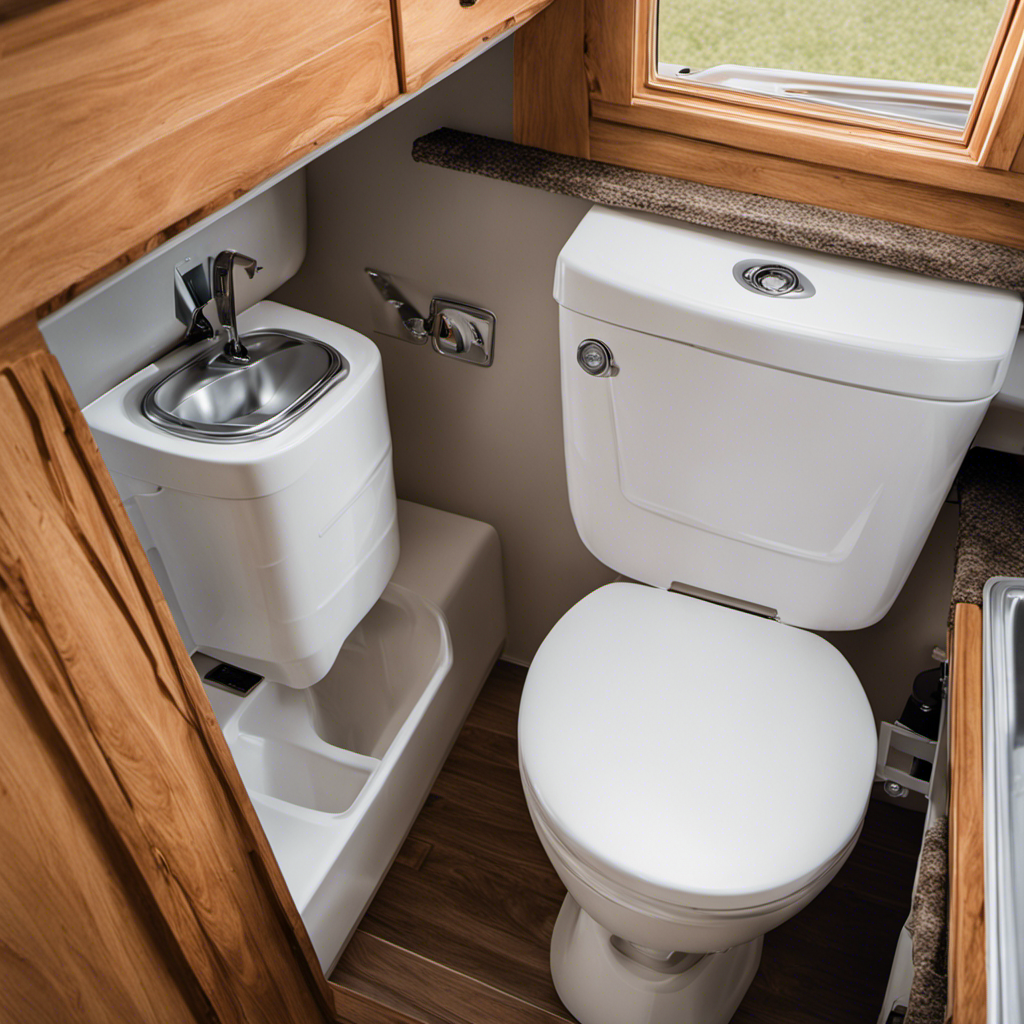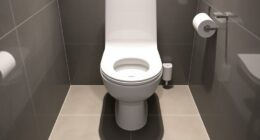Hey there!
Have you ever wondered if there’s a better way to do your business on the toilet? Well, guess what? I’ve got some surprising news for you – squatting on the toilet might just be the answer!
In this article, I’ll be sharing with you all the benefits of this unique technique, as well as the proper technique itself. So get ready to revolutionize your bathroom routine and say goodbye to common mistakes.
Let’s dive in and discover the secrets of squatting on the toilet!
Key Takeaways
- Squatting aligns the rectum properly, reducing the risk of straining and hemorrhoids.
- Squatting promotes a complete bowel movement, preventing constipation.
- Squatting helps prevent urinary tract infections by fully emptying the bladder.
- Squatting improves digestion and overall bowel health.
Benefits of Squatting on the Toilet
Did you know that squatting on the toilet has numerous benefits for your health? Many people are unaware of the advantages of adopting the right toilet posture.
When we squat, our bodies are in a more natural position for elimination, allowing for a smoother and more efficient process. Squatting helps to align the rectum properly, which reduces the risk of straining and hemorrhoids. It also promotes a complete bowel movement, preventing issues like constipation.
Additionally, squatting on the toilet can help to prevent urinary tract infections by fully emptying the bladder. Overall, this simple change in posture can have a significant impact on our health and well-being.
Now, let’s explore the proper technique for squatting on the toilet.
Proper Technique for Squatting on the Toilet
Using the correct form and posture is crucial for effectively utilizing this method. When squatting on the toilet, it’s important to have the right toilet squatting equipment. Here are some key tips to keep in mind:
- Place a squatting platform or stool in front of the toilet to elevate your feet.
- Keep your back straight and your feet shoulder-width apart.
- Slowly lower yourself into a squatting position, ensuring that your knees are directly over your ankles.
- Rest your elbows on your knees for support and balance.
Squatting on the toilet has numerous health benefits, such as improved digestion and prevention of hemorrhoids. By following these proper techniques, you can maximize the advantages of this method.
Now, let’s focus on preparing your body for squatting on the toilet.
Preparing Your Body for Squatting on the Toilet
Before attempting to elevate your feet, it’s important to stretch your leg muscles. Strengthening your leg muscles is crucial for maintaining balance and stability while squatting on the toilet.
Regular stretching exercises such as lunges, hamstring stretches, and calf stretches can help improve flexibility and prevent injuries. Additionally, incorporating exercises like squats, leg presses, and step-ups into your fitness routine can further strengthen your leg muscles, making it easier to squat on the toilet.
Strong leg muscles also promote better blood circulation and can help improve digestion. By engaging these muscles, you increase the pressure in your abdominal region, aiding in the movement of food through your digestive system.
Strengthening your muscles and improving digestion are key components in preparing your body for squatting on the toilet.
Common Mistakes to Avoid When Squatting on the Toilet
To maximize your comfort and prevent injuries, it’s important to be mindful of some common mistakes when you squat on the toilet. Here are a few things to avoid:
-
Leaning too far forward: This can put excessive strain on your lower back and increase the risk of injury.
-
Using improper form: Make sure your feet are shoulder-width apart and your knees are aligned with your toes. This will ensure proper alignment and prevent unnecessary strain on your joints.
-
Holding your breath: Remember to breathe steadily throughout the movement to maintain stability and avoid dizziness or lightheadedness.
-
Rushing the movement: Take your time when squatting on the toilet to maintain balance and control. Rushing can lead to instability and potential accidents.
How to Maintain Balance While Squatting on the Toilet
Maintaining balance while squatting on the toilet is crucial for preventing accidents and ensuring a safe experience. To achieve this, there are a few key techniques to keep in mind.
First, make sure both feet are firmly planted on the ground, shoulder-width apart. This will provide a stable base of support.
Next, engage your core muscles to help maintain your balance throughout the movement. Keep your back straight and avoid leaning too far forward or backward.
Additionally, placing your hands on your thighs can provide extra stability.
By maintaining balance during the squatting position, you not only reduce the risk of falling, but you also allow for better digestion. Squatting promotes improved bowel movements by straightening the rectum and facilitating the release of waste.
Tips for Incorporating Squatting Into Your Bathroom Routine
When incorporating squatting into your bathroom routine, remember to focus on proper form and technique for optimal results. Squatting has been shown to have numerous benefits for bathroom health compared to sitting on a toilet.
Here are some tips to help you incorporate squatting into your routine effectively:
- Start by placing your feet shoulder-width apart on the floor.
- Lower your body down into a squat position, keeping your back straight.
- Use your leg muscles to support your body weight.
- Take deep breaths and relax your pelvic floor muscles to facilitate the process.
Squat toilets have a long history and cultural significance in many parts of the world. They are believed to promote better bowel movements and prevent various health issues. So, whether you choose to squat or sit, understanding the benefits and techniques of squatting can contribute to your overall bathroom health.
Frequently Asked Questions
Can Squatting on the Toilet Improve Digestion and Prevent Constipation?
Squatting on the toilet can improve digestion and prevent constipation. It is a natural elimination technique that promotes improved gut health. By elevating the knees, it aligns the colon for easier and more efficient bowel movements.
Are There Any Potential Risks or Drawbacks to Squatting on the Toilet?
There are potential risks and drawbacks to squatting on the toilet. It can lead to slips and falls, especially for those with mobility issues. However, the benefits of improved digestion and prevention of constipation may outweigh these risks.
How Long Should I Hold the Squat Position When Using the Toilet?
When using the toilet with a squatting posture, it is recommended to hold the position for as long as necessary to complete the task. This position can help improve bowel movements and alleviate constipation.
Can Squatting on the Toilet Help With Pelvic Floor Muscle Strength?
Squatting on the toilet can indeed strengthen pelvic floor muscles. It’s like a secret workout for your nether regions. By engaging those muscles in a squatting position, you’ll reap the benefits of pelvic floor exercises.
Are There Any Specific Medical Conditions or Situations Where Squatting on the Toilet Is Not Recommended?
There may be medical risks associated with squatting on the toilet for certain conditions or situations. It is important to consult with a healthcare professional to determine if it is safe or if alternative options should be considered.
Conclusion
In conclusion, squatting on the toilet can bring a plethora of benefits to your bathroom experience. By using the proper technique, preparing your body, and avoiding common mistakes, you can optimize your squatting experience.
Maintaining balance is key, so remember to engage your core and use the support of your hands. Don’t forget to incorporate squatting into your bathroom routine for a more natural and efficient way of eliminating waste.
So start squatting and say goodbye to bathroom woes!










